From our resource library for organizational scheduling and management.
10 Great Scheduling Apps to Organize Your Life
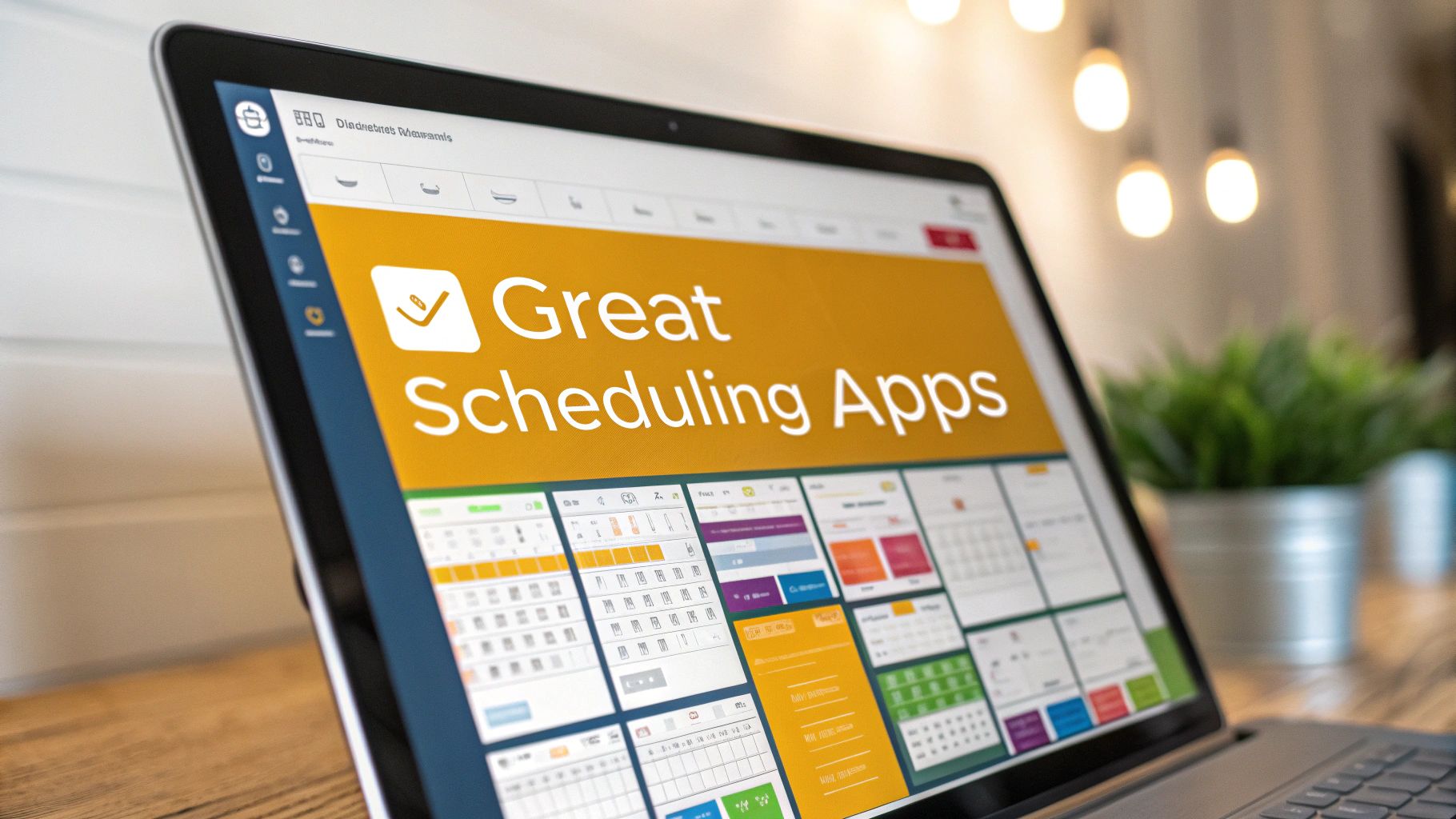
Taking Control of Your Time: A World of Scheduling at Your Fingertips
Scheduling today is essential, especially for those working in demanding jobs like first response, healthcare, and critical services. Professionals in EMT, firefighting, retail, manufacturing and construction all need reliable ways to coordinate shifts and manage complex schedules. Gone are the frustrating days of paper schedules and endless phone tag - those outdated methods simply don't work for modern workplaces that need real-time coordination and quick responses.
What makes scheduling software actually useful? The best solutions go far beyond basic calendars. They seamlessly fit into your existing workflow with simple interfaces while offering powerful features built for specific industries. Key capabilities include:
- Easy shift swapping
- On-call rotation management
- Time-off request handling
- Automated schedule reminders
- Conflict prevention tools
Whether you're coordinating military deployments, managing security patrol schedules, or running restaurant staff shifts, the right scheduling tool can make a major difference in your daily operations.
In this guide, we'll explore ten top scheduling apps, breaking down what makes each one stand out and which types of teams they work best for. Get ready to find the perfect solution to simplify your scheduling process, cut down on administrative work, and take back control of your time.
1. Acroroster
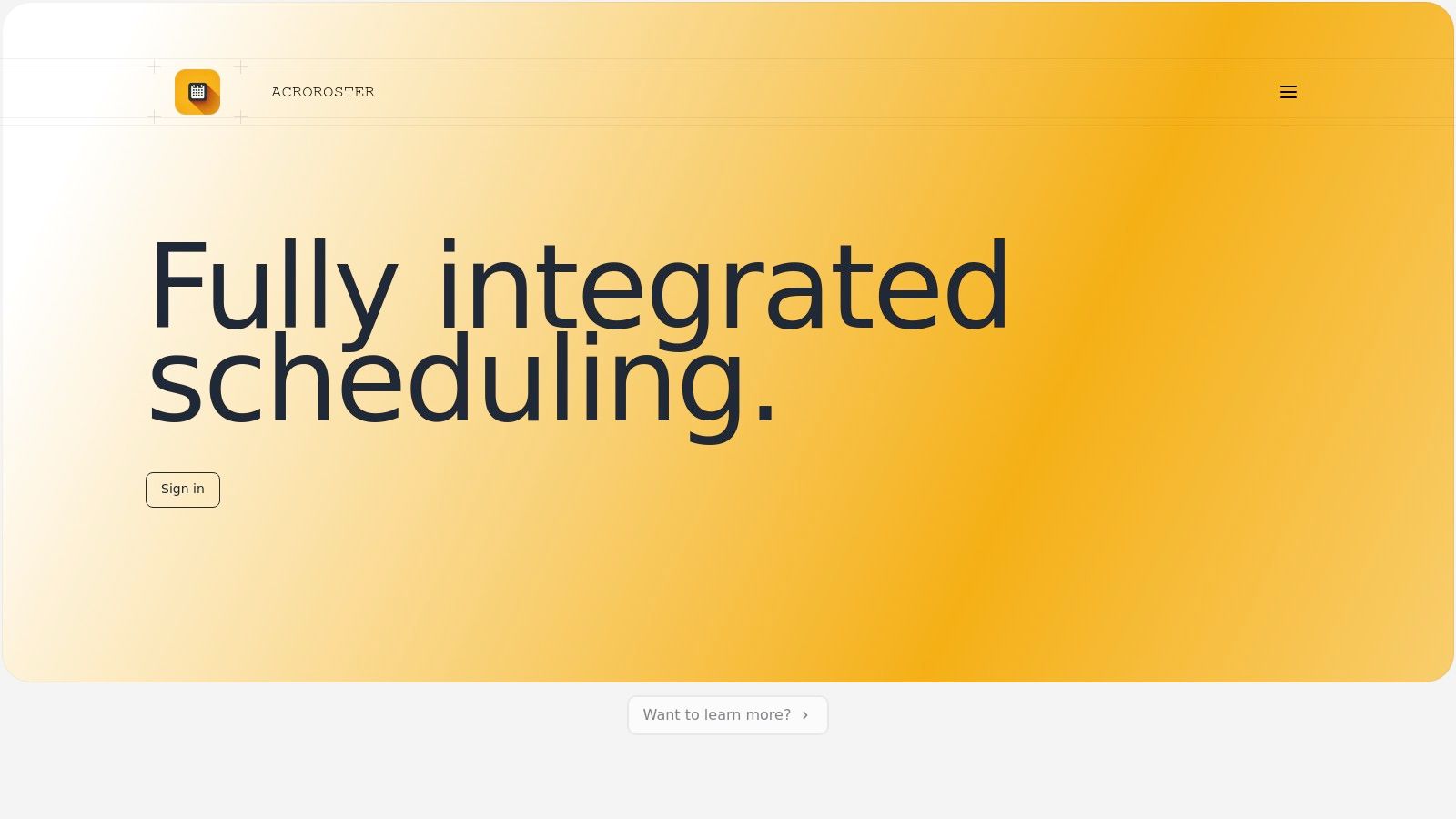
Acroroster is a powerful cloud-based scheduling platform built for organizations that need precise staff management across multiple shifts and locations. It's especially well-suited for first responders, healthcare providers, military units, retail operations, restaurants, manufacturing facilities, construction sites, and security services.
Managing complex schedules becomes simple with Acroroster's integrated approach. The platform makes it easy to handle rotating shifts for fire departments, coordinate hospital staff schedules, and ensure proper coverage for large security operations. With an intuitive interface, teams can quickly create and manage comprehensive rosters and shift assignments - perfect for 24/7 operations with frequent staffing changes.
What makes Acroroster stand out is its custom database integration and enterprise-level support. Unlike solutions aimed at small businesses, Acroroster excels at handling the complex scheduling needs of larger organizations and specialized industries. The platform can be customized to work with your existing data systems while providing dedicated support to help you get the most value.
Key Benefits:
- Cloud-based platform accessible from anywhere with real-time updates
- Enterprise-grade support and custom database integration options
- Handles complex scheduling for multiple industries and use cases
- User-friendly interface reduces administrative work
- Manages shift rotations, on-call schedules, and time-off requests
Potential Drawbacks:
- Pricing requires contacting sales for a custom quote
- More features may mean a steeper learning curve for small teams
Since Acroroster runs in the cloud, it works with standard web browsers and operating systems. Implementation involves working with their team to configure the platform for your needs and train your staff.
For more insights on choosing the right scheduling software, check out their guide: The Ultimate Guide to Employee Scheduling Applications: Streamline Your Workforce Management
Learn more about Acroroster's capabilities at acroroster.com.
2. Calendly: Scheduling Made Simple
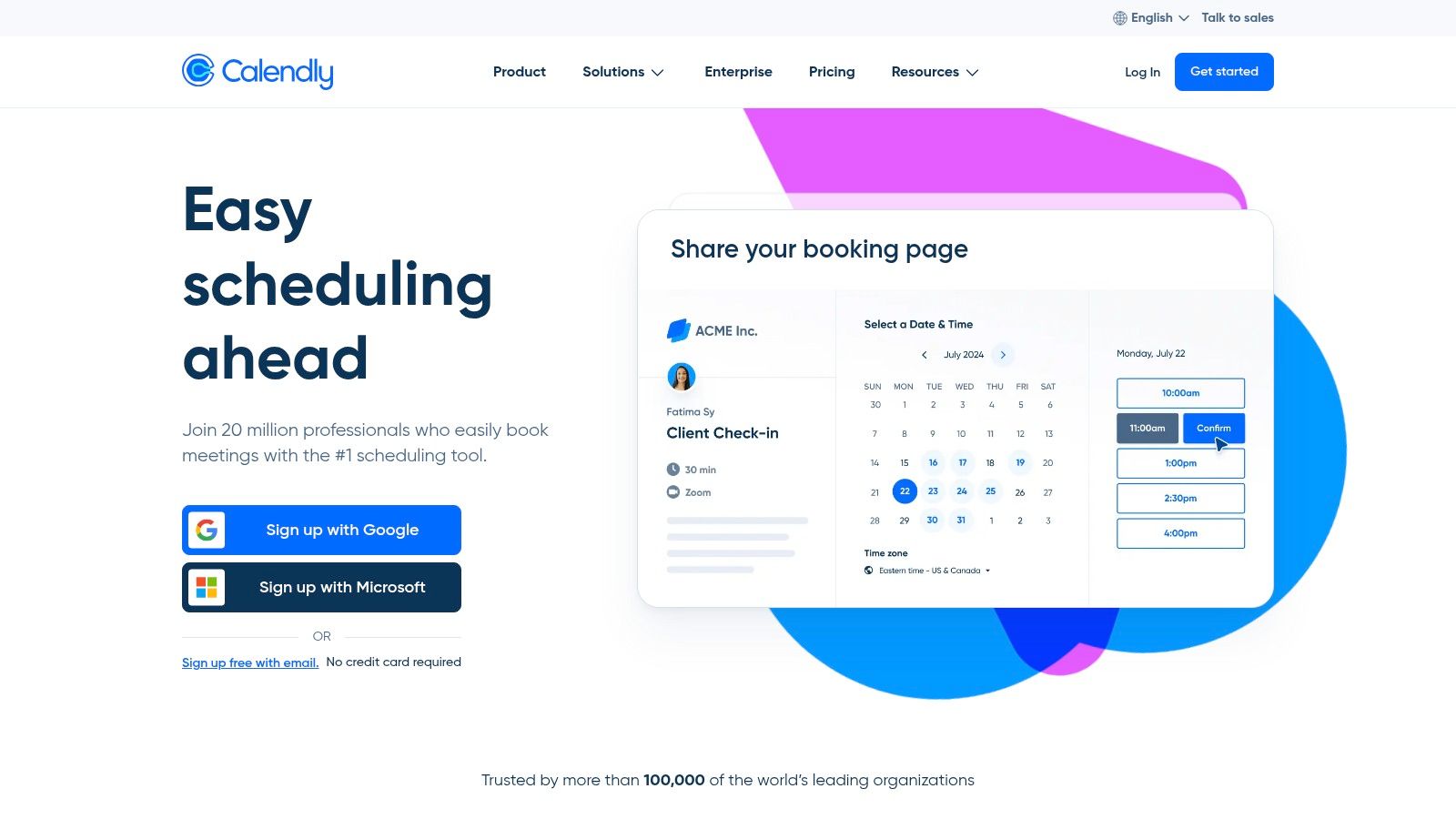
Calendly stands out as a practical scheduling tool that makes booking meetings effortless. By removing the back-and-forth emails typically needed to schedule meetings, it saves valuable time for more important work. This tool proves especially useful for professionals like paramedics scheduling training, restaurant managers organizing staff shifts, or construction supervisors planning site meetings.
The Basic Process: The app connects with your existing calendar (Google Calendar, Office 365, Outlook) and lets you set your available times. You can create specific meeting types (like quick 15-minute chats or hour-long team meetings) with their own rules. Share your Calendly link, and others can pick times that work for everyone - the meeting gets added to all calendars automatically.
Main Features:
- Smart Scheduling: No more email chains. EMTs and firefighters can quickly book training sessions and community events.
- Custom Time Rules: Set specific hours, add buffer time between meetings, and block last-minute bookings - perfect for shift workers with changing schedules.
- Calendar Integration: Works smoothly with major calendar apps to prevent double-booking. Essential for managing large teams.
- Team Scheduling: Makes it easy to plan group meetings and training. Great for restaurant staff meetings or retail training sessions.
- Meeting Reminders: Sends automatic notifications to reduce no-shows. Helpful for healthcare providers and military personnel.
Benefits:
- Simple to Use: Even people who aren't tech-savvy can set it up quickly
- Works With Popular Calendars: Keeps schedules in sync across different platforms
- Built-in Reminders: Helps everyone show up on time
Limitations:
- Basic Free Version: Features like group scheduling require paid plans
- Premium Costs: Full access to advanced tools comes at a higher price
Cost Breakdown: Free basic plan available. Paid plans begin at $8 per user monthly.
System Needs: Works with an internet connection and a supported calendar service.
Quick Tip: Try the free version first to learn the basics. As your needs grow, you can upgrade for more features like group scheduling and custom branding.
Website: Calendly.com
3. Google Calendar
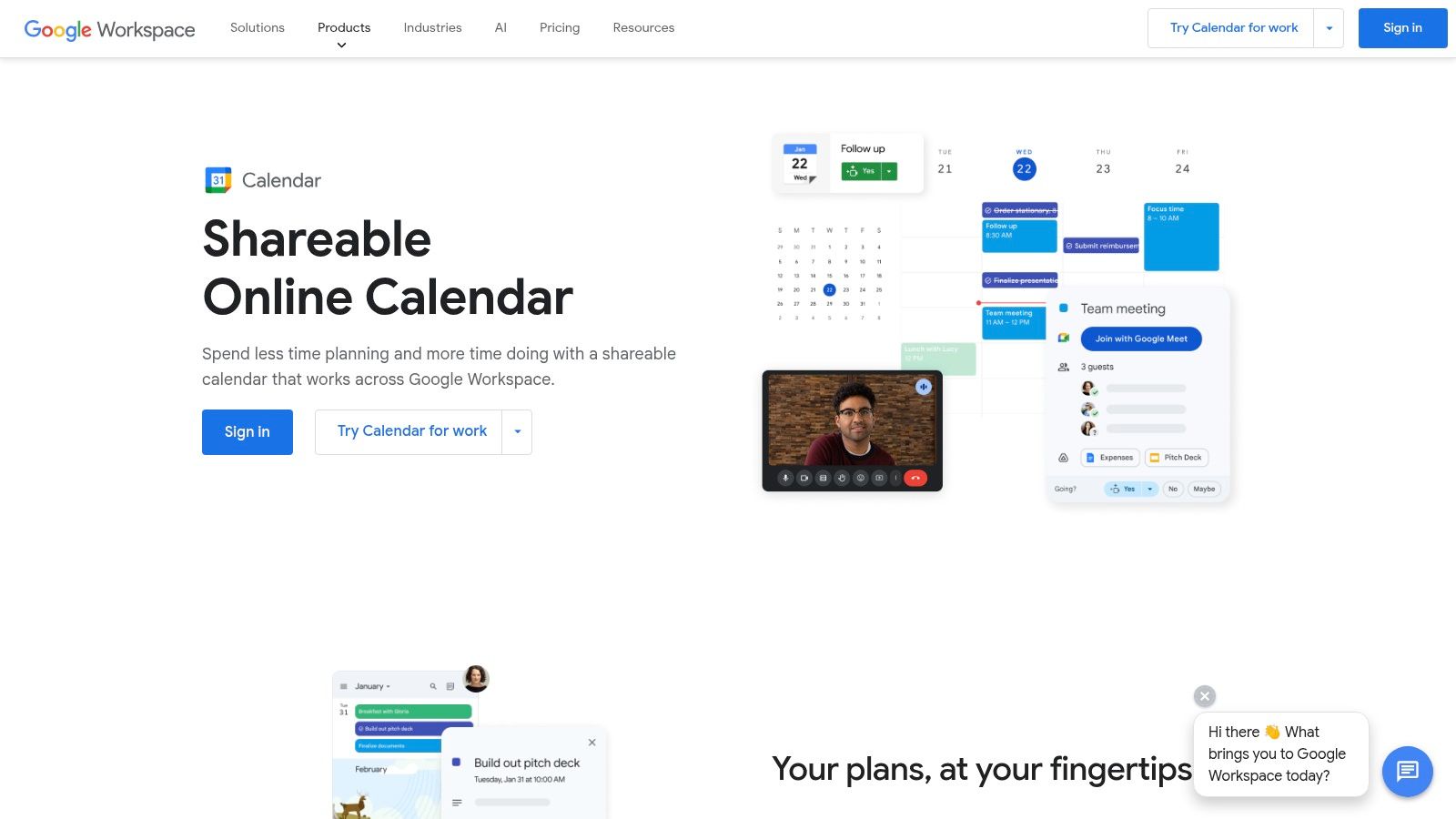
Google Calendar is a simple but powerful free scheduling tool that excels at making calendar management easy and accessible. Whether you're a healthcare worker managing shifts or a business owner coordinating team schedules, its straightforward interface and integration with other Google tools make it a go-to choice.
For first responders and medical staff, managing complex schedules is part of daily life. Google Calendar shines here - you can create separate calendars for work shifts, on-call duties, and personal time, viewing them either combined or individually. Share schedules with your team to handle shift swaps smoothly and ensure proper coverage at all times.
The tool works equally well across many industries. Store managers can plan employee schedules and track availability. Construction teams can manage deliveries and coordinate contractors. Security firms can organize patrol rotations. Even military units find it useful for planning exercises and leave schedules.
Features:
- Multiple Calendar Views: See your schedule by day, week, month or year
- Event Sharing and Collaboration: Share calendars and plan events together
- Smart Suggestions: Get helpful recommendations for event details based on your patterns
- Cross-Platform Access: Use it on any device with automatic syncing
Pros:
- No cost to use: Perfect for small teams and individuals
- Works smoothly with Gmail and other Google tools
- Clean, simple interface: Easy for anyone to learn
Cons:
- Basic features only: Missing some advanced scheduling capabilities
- Google account needed: Not usable without signing up
Setup Tips:
- Use color coding: Make different calendars instantly recognizable
- Set up appointment slots: Simplify booking times with others
- Create recurring events: Save time on regular meetings/shifts
- Connect other apps: Link with tools like Slack for better workflow
Website: https://calendar.google.com
While Google Calendar may not have every bell and whistle, its free access and straightforward design make it an excellent choice for managing schedules. The clean interface and Google ecosystem integration help teams stay coordinated, from healthcare workers to retail staff.
"Section 4: Microsoft Outlook Calendar":
4. Microsoft Outlook Calendar
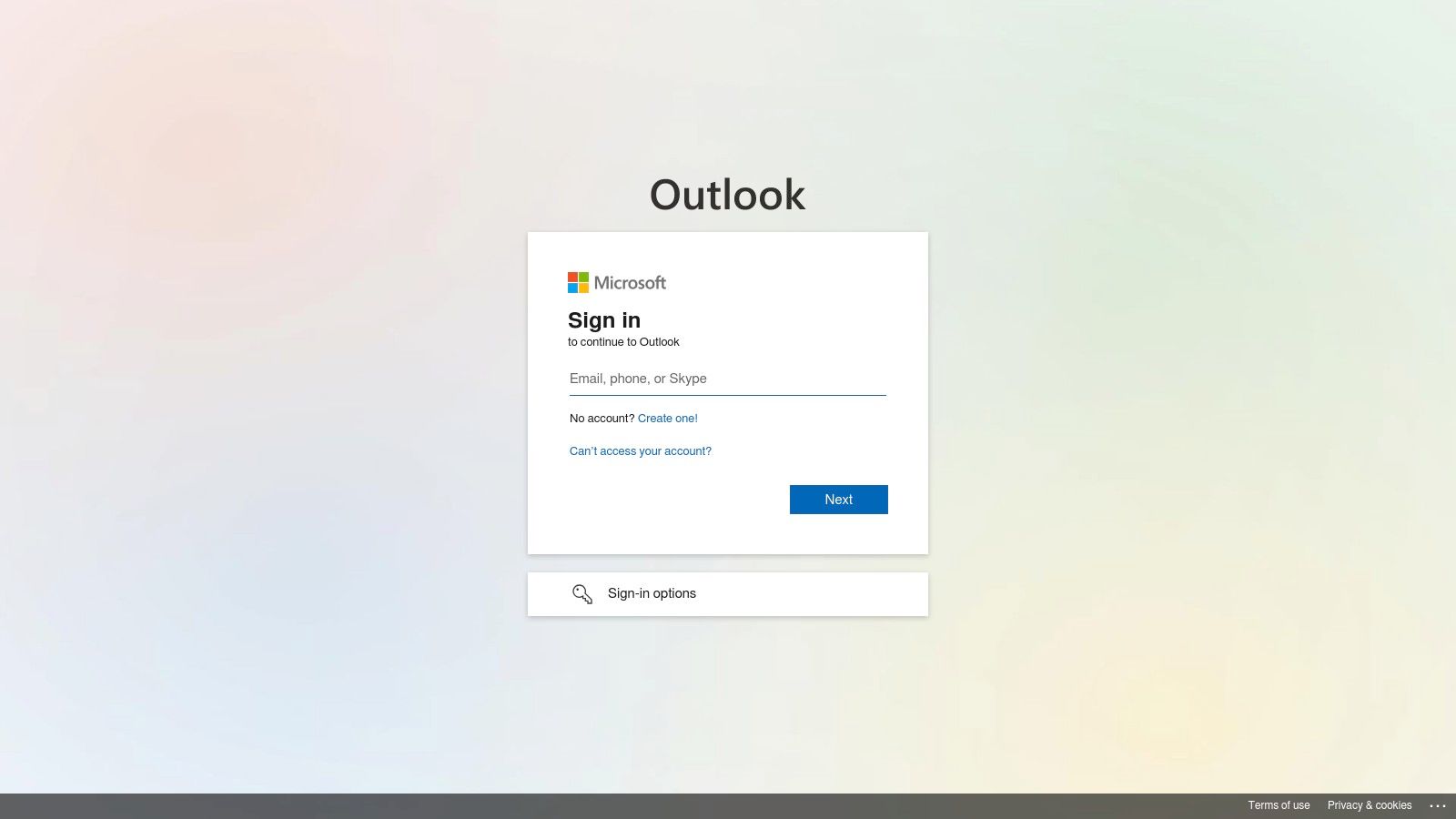
Microsoft Outlook Calendar helps teams stay organized and manage complex schedules. It works especially well for first responders, healthcare workers, and staff in retail, manufacturing and construction. Since it's part of Microsoft 365, it fits naturally into many workplace tech setups.
The calendar does more than basic scheduling. You can suggest multiple meeting times, manage responses, book resources like rooms and equipment, and share calendars with your team. These features make it simple to coordinate shift changes, handle emergencies, and maintain proper staffing levels. The time zone tools are particularly helpful for teams working in different locations.
Industry-Specific Benefits:
- Healthcare & Emergency Services: Share calendars for shift management, quickly arrange emergency coverage, and schedule resources like ambulances
- Retail & Restaurants: Manage employee schedules, track time-off requests, and adjust staffing for busy periods
- Construction & Manufacturing: Plan project timelines, schedule equipment use, and keep teams in sync
- Military: Schedule training, coordinate deployments, and manage resources efficiently
Key Advantages:
- Business-Ready Features: Handles complex scheduling needs with tools for resources, shared calendars, and detailed meeting planning
- Works with Microsoft 365: Connects smoothly with Teams, Word, Excel and other Microsoft tools
- Strong Mobile Support: Check and update your schedule from anywhere
Potential Drawbacks:
- Learning Curve: New users may need time to master all the features
- Cost: Full features require a Microsoft 365 subscription
Using the Calendar:
You can access Outlook Calendar through web browsers, desktop apps (Windows/Mac), and mobile apps (iOS/Android). Pricing varies based on your Microsoft 365 plan.
Getting Started Tips:
- Start Simple: Learn the basics of creating appointments and sharing calendars before exploring advanced features
- Use Help Resources: Take advantage of Microsoft's guides and tutorials
- Personalize Your View: Adjust calendar settings to show what matters most to you
How It Compares:
While Google Calendar is known for simplicity, Outlook Calendar offers more advanced features for business use. It's particularly valuable if your organization already uses Microsoft tools.
Outlook Calendar stands out for its robust scheduling tools and tight integration with Microsoft 365. It helps teams across many industries coordinate more effectively and stay organized.
5. When2Meet

When2Meet stands out for its straightforward approach to scheduling. This free tool focuses solely on finding meeting times that work for everyone - and does it exceptionally well. It's perfect for coordinating across different teams or organizations where managing separate calendars gets messy.
Picture this: You're organizing a training session between different departments, or trying to arrange shift swaps at your workplace. Rather than endless back-and-forth messages, When2Meet gives you one central spot where everyone marks their availability. Users simply open the When2Meet page (no signup needed!), mark their free times on a grid, and instantly see where schedules overlap. The visual layout makes spotting the perfect meeting time quick and easy.
Key Features:
- Visual Grid Display: See everyone's availability at a glance with an easy-to-read grid format
- No Account Needed: Skip the signup process - just share a link and start scheduling
- Instant Updates: Changes appear in real-time as people add their availability
- Time Zone Smart: Automatically handles different time zones, perfect for remote teams
Pros:
- 100% Free: Use all features without any cost
- Easy to Learn: Simple interface that anyone can figure out quickly
- Quick Access: No registration barriers for participants
Cons:
- Simple Design: The basic interface lacks extra features found in other scheduling tools
- Core Focus Only: Sticks to scheduling - no extras like reminders or file sharing
- Web-Only: Works on mobile browsers but has no dedicated app
Tips for Success:
- Name Your Events: Label each scheduling poll clearly (e.g., "Team Training - June" or "Weekly Shift Swap")
- Set Clear Time Windows: Define specific days and times to keep everyone focused
- Share Widely: Make sure everyone has the link through email, chat, or team channels
When2Meet excels at its core purpose: finding times when everyone can meet. If you need a simple, free way to coordinate schedules across a group, When2Meet delivers exactly what you need.
6. Doodle

Doodle helps teams align their schedules through an easy-to-use polling system. This makes it an excellent choice for organizations that need to coordinate many people's calendars, from healthcare teams to manufacturing staff to emergency responders.
Real-World Uses
Police departments and fire stations use Doodle to quickly arrange team meetings without endless email chains. Manufacturing plants rely on it to coordinate shifts across departments, while retail managers use it to plan staff schedules efficiently.
Key Features
- Smart Polling: Create simple polls to find the best meeting time for everyone
- Calendar Sync: Works with your existing calendar apps to keep everything in one place
- Time Zone Support: Automatically converts times for global teams
- Meeting Organization: Gather availability from multiple people in a structured way
What Works Well
Strengths:
- Group Scheduling: Makes it simple to find times that work for everyone
- Simple Interface: Anyone can learn to use it quickly
- Handles Large Teams: Works smoothly even with many participants
Limitations:
- Ads in Free Version: You'll see advertisements unless you upgrade
- Premium Features Cost Extra: Some useful tools require a paid subscription
Plans and Access
The free version includes basic features with ads, while paid plans offer more tools and an ad-free experience. You can use Doodle through any web browser or download apps for iPhone and Android devices.
How It Compares
While other scheduling tools focus on individual calendars, Doodle excels at group coordination through its polling approach. This makes it especially useful when you need input from multiple team members to schedule meetings.
Getting Started
Help your team succeed with Doodle by showing them how to create and respond to polls. Quick training sessions can help everyone get comfortable using it, particularly in fast-paced environments like hospitals or emergency services.
Doodle stands out for making group scheduling straightforward and painless. Its calendar integration and time zone handling make it practical for teams everywhere. Visit their website to learn more about how it can help your organization.
7. Any.do
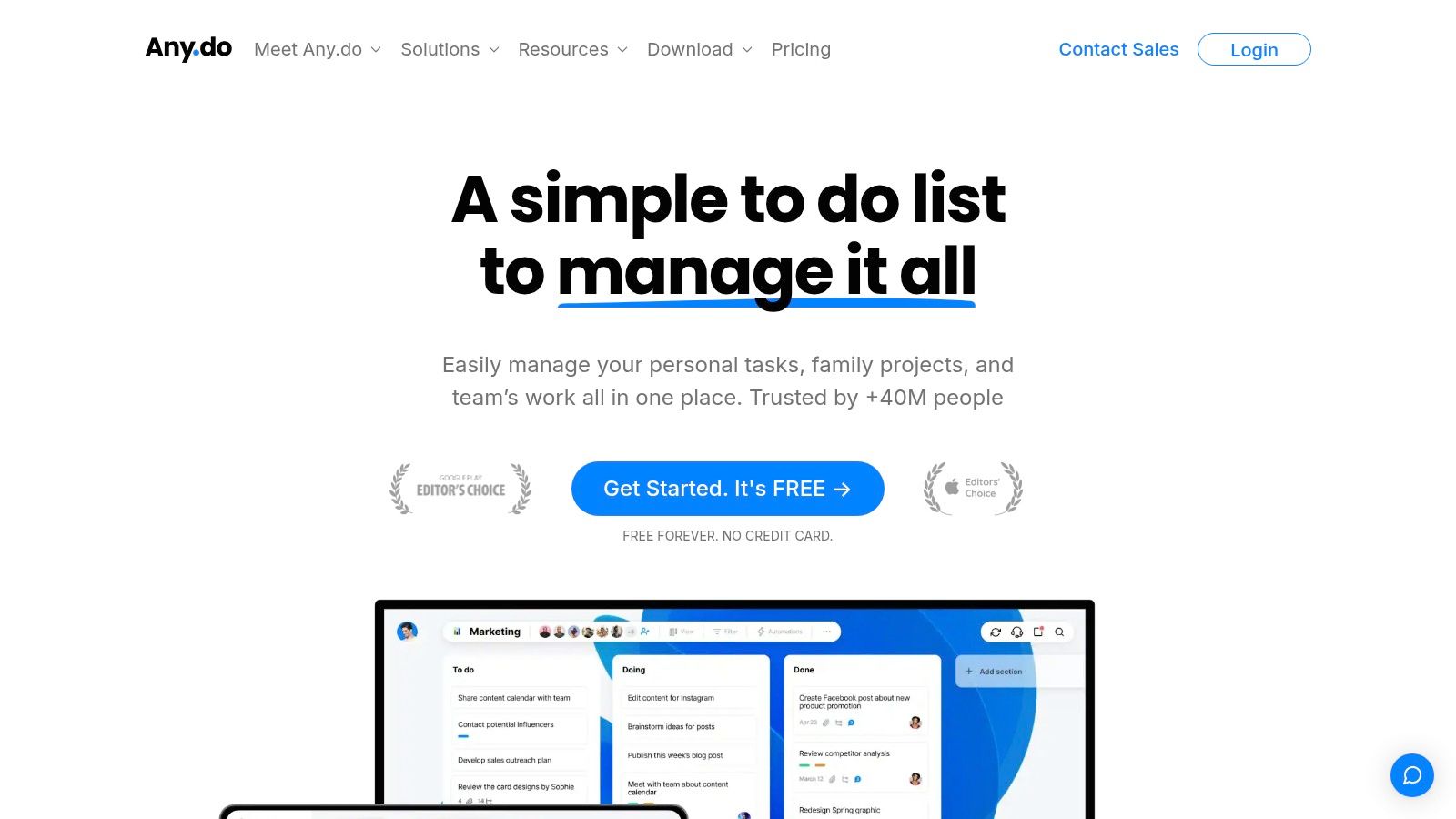
Any.do brings together calendar, tasks, and reminders in one simple app. The platform works great for both personal and work use, making it perfect for busy professionals who need to stay organized across different parts of their life.
Real-World Uses
The app excels in several professional settings:
- Healthcare & Emergency Services: Perfect for managing shifts, setting critical task reminders, and coordinating team activities in fast-paced environments
- Retail & Food Service: Helps track employee schedules, monitor inventory, and manage supply orders
- Construction & Security: Keeps projects on track with calendar sync and location-based task reminders
Key Features
Any.do offers essential tools to stay organized:
- Calendar + Task Integration: See your schedule and to-dos in one view
- Smart Notifications: Set custom reminders that match your work style
- Location Reminders: Get alerts when you arrive at specific places
- Multi-Device Sync: Access your plans from any device
These tools help users handle complex schedules without missing important deadlines.
What Works & What Doesn't
The Good:
- Clean Design: Simple, easy-to-use interface
- Smooth Task Management: Effortlessly link tasks to your calendar
- Clear Daily Overview: See all your commitments at a glance
The Not-So-Good:
- Premium Features Cost Extra: Need to pay for full access
- Sync Issues: Updates between devices can be slow at times
Cost & System Requirements
The basic version is free, but premium features need a subscription. The app works on iOS, Android, and web browsers.
Getting Started Tips
Any.do stands out for its simple but powerful features. To begin:
- Take the app tour to learn the basics
- Install it on all your devices
- Start with a few basic tasks and reminders
For more information, check out the Any.do website.
Why Choose Any.do
Any.do excels at combining task management with scheduling, making it ideal for professionals who need to track multiple responsibilities. Its straightforward approach helps users stay focused and organized.
8. Schedule Once
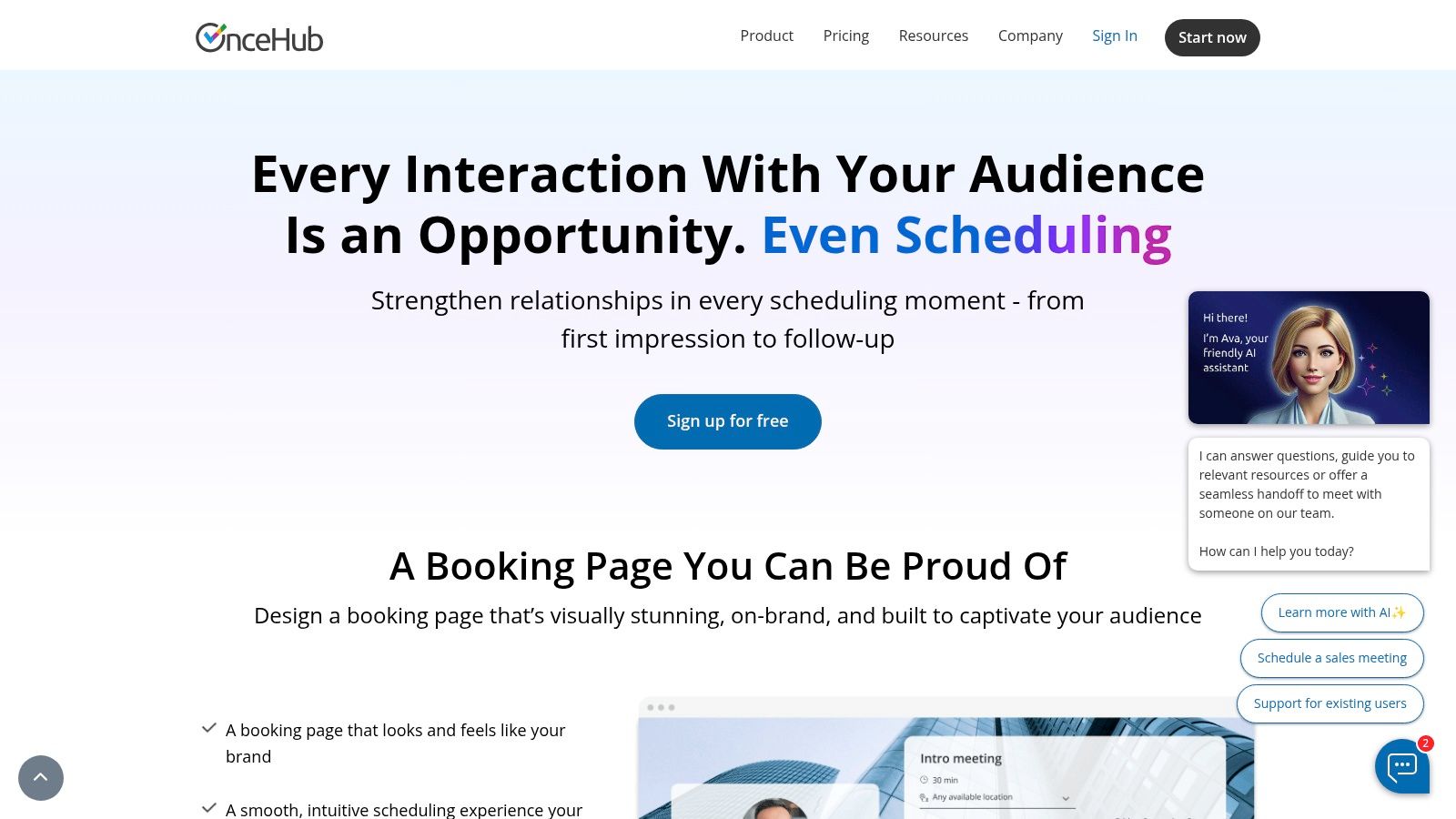
Schedule Once helps businesses manage their team schedules and customer appointments seamlessly. The platform works well for different industries including healthcare, retail, security services and more.
Let's look at how Schedule Once helps different businesses. First responders, police, firefighters, EMTs and healthcare workers use it to coordinate shifts and handle emergency scheduling. Retail stores and restaurants rely on it to book customer appointments and organize staff schedules effectively.
Key Features:
- Multiple booking pages for different locations/services
- Team scheduling with clear visibility for all members
- Payment processing integration
- Custom branding options
- Advanced reporting tools
Schedule Once stands out because businesses can set up separate scheduling pages for each location or service type. The team features keep everyone coordinated, while payment processing lets you handle transactions right in the system.
What Works Well:
- Complete scheduling solution for mid to large teams
- Flexible customization options
- Strong analytics and reporting capabilities
Potential Drawbacks:
- Higher pricing compared to basic scheduling tools
- Takes time to learn all features
For best results when setting up Schedule Once, start by identifying your specific scheduling challenges. Then configure the features that address those needs. Plan some training time to help your team get comfortable with the system.
When comparing Schedule Once to similar apps, it excels at handling complex scheduling needs and offers excellent integration options. However, smaller teams with basic requirements may want to explore more affordable alternatives. Learn more in our Ultimate Guide on Scheduling Shifts.
Schedule Once earns its spot on this list by helping businesses manage complex scheduling efficiently. It works particularly well for industries that need precise timing and resource coordination, like manufacturing, construction and military operations.
9. Calendar.com
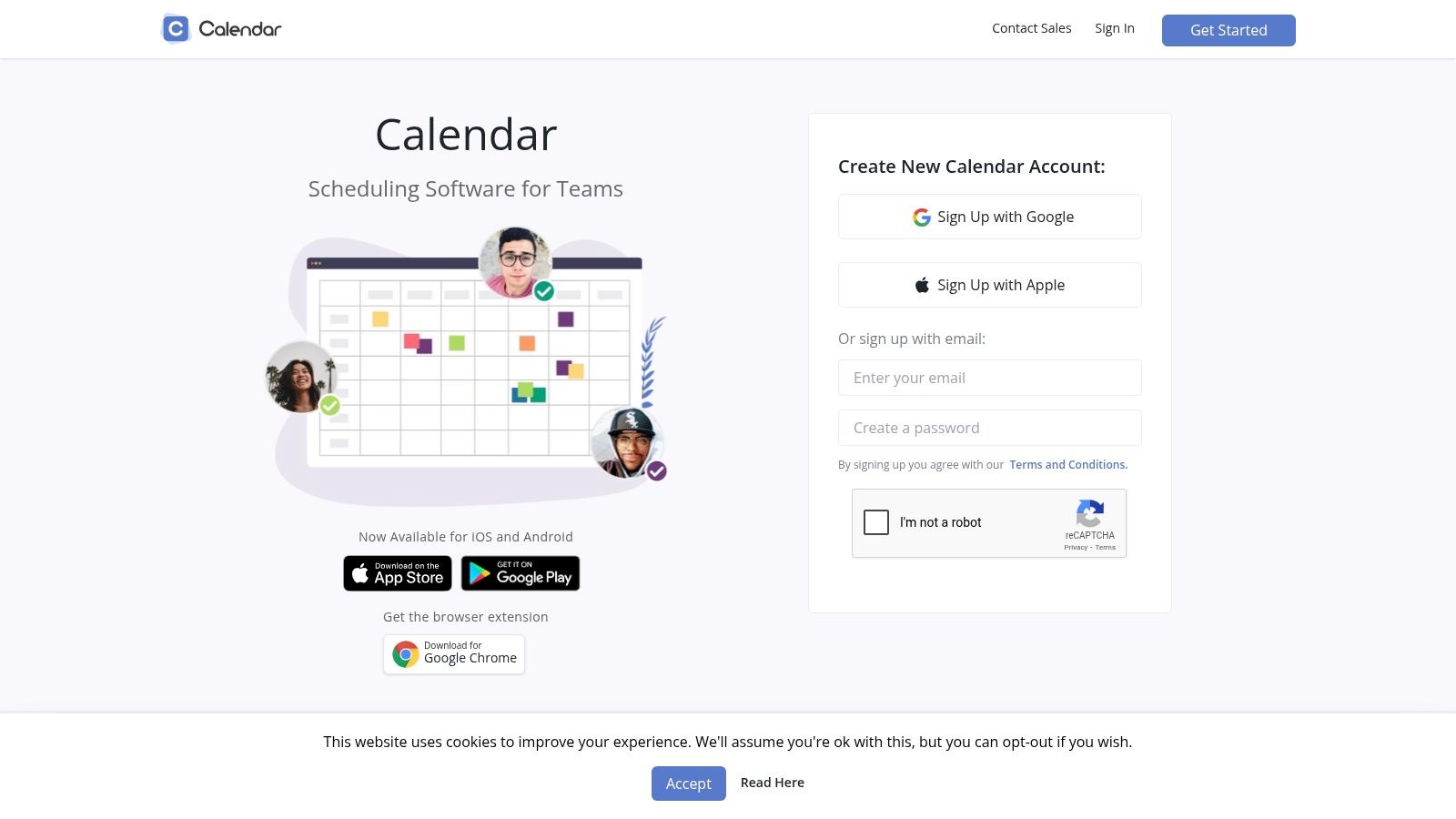
Time management is essential for professionals in demanding fields like emergency response, healthcare, and construction. Calendar.com stands out as a smart scheduling tool that uses AI to help optimize your schedule. It works equally well for personal and work scheduling, making it ideal for high-pressure environments.
Real-World Applications
Calendar.com excels in industries with unpredictable schedules. Emergency services teams use the AI scheduling features to coordinate shifts and training. The team features help firefighters and police departments stay in sync for time-critical operations.
The meeting transcription feature proves valuable in retail and manufacturing, where clear documentation of discussions helps teams follow through on action items.
Key Features
- AI-Powered Scheduling: Get smart suggestions for optimal meeting times and automate scheduling tasks
- Time Analytics: See how you spend your time to boost productivity and find areas to improve
- Meeting Records: Auto-transcribe meetings to keep clear documentation
- Team Tools: Easy coordination between team members to prevent scheduling conflicts
What Works Well and What Could Be Better
Strong Points:
- Smart AI scheduling sets it apart from basic calendar apps
- Simple, clean interface that's easy to use
- Strong privacy controls to keep data secure
Areas for Improvement:
- Newer platform with a smaller user community
- Premium pricing may not suit all budgets
Cost and System Needs
Pricing varies based on team size and needs. Check the Calendar.com website for current rates and trial options.
How It Compares
Calendar.com's AI capabilities and meeting transcription make it stand out from standard scheduling tools. It's built to handle complex scheduling needs beyond basic calendar management.
Getting Started Tips
Start by connecting Calendar.com to your existing calendar apps like Google Calendar or Outlook. This ensures a smooth transition and keeps your workflow intact. Consider training sessions to help your team learn all the advanced features.
Final Thoughts
Calendar.com has earned its spot among top scheduling tools by offering practical solutions for demanding work environments like healthcare and emergency services. Its AI-powered scheduling makes it a great choice for organizations looking to make time management more efficient.
For full details on features and capabilities, visit Calendar.com.
10. TimeTree
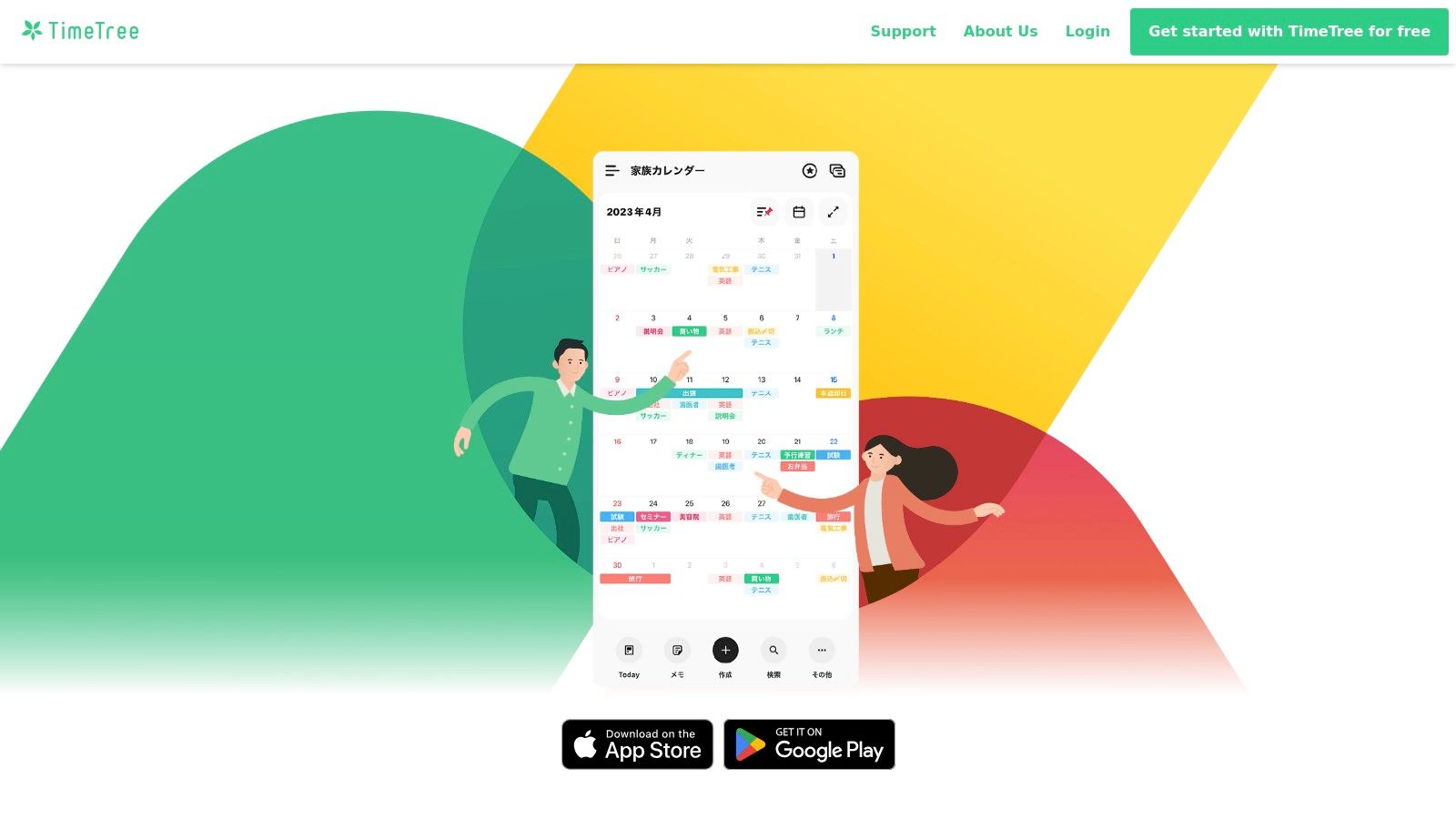
Keeping everyone's schedules in sync can be tricky, especially for families and small teams. TimeTree solves this by offering a shared calendar platform where everyone can track important dates and events together. The app works particularly well for first responders, healthcare teams, restaurant staff, and anyone balancing personal and work commitments.
Features and Practical Applications
The core of TimeTree is its shared calendar system, which lets multiple people view and edit events seamlessly. This makes it ideal for families managing busy schedules or small teams aligning their activities.
For police, firefighters, EMTs, and military personnel who deal with changing shifts and last-minute schedule updates, the built-in chat feature proves invaluable. Healthcare workers, restaurant teams, and retail staff benefit from the ability to categorize events and share photos directly within the app.
Setup and Use
Getting started with TimeTree is simple. The app is available on both Android and iOS platforms. After signing up, you can invite family or team members through email or the app itself. The app connects with Google Calendar and Apple's Calendar for easy integration with existing schedules.
Pricing and Technical Requirements
The app offers a free basic version that works well for most families and small groups. Premium features are available for those who need more advanced options. TimeTree runs on Android 5.0+ and iOS 11.0+ devices.
Comparisons and Alternatives
While Google Calendar and Microsoft Outlook are popular choices, TimeTree excels at group scheduling and interaction, especially for non-business users. Teams needing advanced project management might want to explore other options. For more scheduling tools, check out our guide on Free Staff Roster Template Excel: Master Your Employee Scheduling Today.
Why It Deserves a Spot
TimeTree earned its place on our list by doing one thing exceptionally well: making group scheduling easier. Its simple design and practical features help families and small teams stay coordinated, making it especially useful for jobs that require quick responses and teamwork.
Pros and Cons
Pros:
- Perfect for family scheduling
- Free basic plan
- Easy to learn and use
Cons:
- Limited business features
- Some features not available in all regions
TimeTree helps groups and families manage their time better together. It's especially useful for healthcare workers, emergency responders, and small operational teams who need to stay in sync.
Top 10 Scheduling Apps: Core Features & Usability Comparison
| Tool | Ease of Use | AI Capabilities | Output Quality | Pricing | Best For | Standout Feature |
|---|---|---|---|---|---|---|
| 🏆 Acroroster | ★★★ | ★ | ★★★★ | 💰 Inquire | Complex scheduling | Cloud integration & enterprise support |
| Calendly | ★★★★ | ★ | ★★★★ | 💰 $$ | Direct booking | Automated scheduling |
| Google Calendar | ★★★★ | ★★ | ★★★★ | 💰 Free | Everyday use | Google integration |
| Microsoft Outlook Calendar | ★★★ | ★★ | ★★★★ | 💰 Premium | Business integration | Microsoft 365 integration |
| When2Meet | ★★★★ | ★ | ★★ | 💰 Free | Quick polls | No registration |
| Doodle | ★★★★ | ★ | ★★★★ | 💰 $ | Group scheduling | Poll-based scheduling |
| Any.do | ★★★★ | ★★ | ★★★★ | 💰 Freemium | Productivity | Task & calendar integration |
| Schedule Once | ★★★ | ★ | ★★★★ | 💰 $$$ | Business scheduling | Team scheduling |
| Calendar.com | ★★★★ | ★★★★ | ★★★★ | 💰 $$$ | Personal & pro | AI insights |
| TimeTree | ★★★★ | ★ | ★★★★ | 💰 Free basic | Family & groups | Shared calendars |
Scheduling Success: Finding the Perfect App for You
A good scheduling app can make managing your time much simpler while helping you get more done. From small teams to large organizations with multiple shifts and locations, having the right tool is essential. Today's options range from basic calendars to full-featured platforms like Acroroster, giving you plenty of choices to match your needs.
Several key factors should guide your decision. Think about your team size, how complex your scheduling needs are, and whether you need the app to work with other software you use. For personal use or small teams with straightforward needs, free tools like When2Meet or Google Calendar might do the job. But larger organizations, especially in healthcare, emergency services, or security, typically need more specialized solutions.
Getting the most from your scheduling app requires good planning. Start by listing out what you want to achieve and identifying problems with your current approach. Take time to learn the app's features through tutorials and documentation. Make sure your team is involved in setting up the new system and encourage them to share feedback.
Cost is worth careful consideration. While basic features are often free, advanced capabilities usually require a paid subscription. Compare the subscription cost against the time and effort you'll save through better scheduling. Also factor in whether you'll need IT support to maintain the system.
Check that your chosen app works smoothly with your existing tools. If you rely on specific HR, payroll, or team chat software, verify that the scheduling app can connect with those systems. This helps avoid duplicate data entry and keeps information flowing between systems.
Key points to evaluate when selecting a scheduling app:
- Growth potential: Will the app scale up as your needs expand?
- Core capabilities: Does it include the specific features your team needs?
- User-friendly design: Can everyone on the team easily learn and use it?
- Available help: What kind of training and support does the provider offer?
- Data protection: Are there proper security measures and compliance features?
For organizations managing complex schedules in time-critical fields like emergency response, healthcare, and security, Acroroster provides a complete solution. The platform helps you handle staff rosters, shift assignments, and availability tracking through an easy-to-use cloud interface. With enterprise features like custom database connections and dedicated support, Acroroster helps optimize your scheduling operations and reduce administrative work. See how Acroroster can improve your scheduling - visit their website to request a demo.